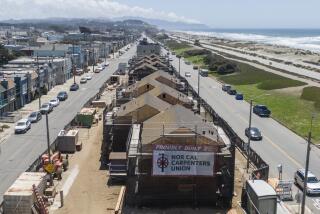Case-Shiller home price index hits new post-financial crisis low
A key measure of home prices in large U.S. cities fell to a new post-financial crisis low in January, the latest indication that the housing market continues to hunt for a bottom even as sales pick up.
Economists expected the drop and largely shrugged off the news that the widely followed home price index declined to a level lower than even during the depths of the financial crisis. The Standard & Poor’s/Case-Shiller index in January fell 0.8% from December and dropped 3.8% from January 2011.
Sixteen cities tracked by the index posted declines. Eight metro areas — Atlanta, Chicago, Cleveland, Las Vegas, New York, Seattle, Portland, Ore., and Tampa, Fla. — saw average home prices hit new lows. Nevertheless, many analysts said they believe conditions are set for the long housing decline to plateau this year and begin a sluggish recovery.
“Falling prices are not so much a reflection of market health, but rather the result of banks disposing of distressed assets by offering low prices to cash buyers,” said Gary Painter, an economist with the USC Lusk Center for Real Estate. “As these distressed properties are taken off the market, that trend will end.”
With rental rates increasing and the jobs picture brightening, a bottom should be expected this year, Painter said.
All of the California cities in the index posted drops from the prior month. Los Angeles, San Diego and San Francisco fell 0.8%, 1.1% and 2.5%, respectively. In January, Washington, Miami and Phoenix were the only metro areas that posted monthly gains.
The latest declines continue a slide that began last year as sales weakened and the jobs picture remained bleak. In recent months investors have poured into the market, snapping up foreclosures and other distressed properties to quickly refurbish and resell or to hold and rent — helping boost sales.
A big hindrance to the market’s recovery remains the lack of so-called move-up buyers, or those people who have gained enough equity in their homes to sell their properties and buy a bigger, pricier property. Mortgages have also been tough to obtain because of tough underwriting criteria by banks, experts, brokers and real estate agents have said.
Although the Case-Shiller index fell further in January, economists noted that the rate of annual decline softened, meaning that price declines were probably moderating. The same was true for half of the cities tracked by the index, including San Diego.
The index is published on a seasonally adjusted basis and a non-adjusted basis, but analysts have warned that the adjusted version is unreliable given the distortions produced by the large number of foreclosures on the market. January is not a particularly good indicator of where the housing market is headed and improvement may not be logged until the spring months, when many shoppers begin looking for homes in earnest, analysts said.
Ian Shepherdson, chief U.S. economist for High Frequency Economics, said in a note to clients that home prices should be largely viewed as “stable” and that there is room for optimism.
“A sustained recovery in home prices is still a long way off, but stabilization is an essential first step, not least because no one wants to borrow money to buy a depreciating asset,” Shepherdson said. “When prices stabilize, having been falling, the implied real mortgage rate falls, prompting increased sales. This could, therefore, be the start of a virtuous circle.”
Paul Dales, an economist with Capital Economics, wrote in a note that the Case-Shiller data showed home prices were “on the mend.”
“We expect that 2012 will go down in history as the year that the most severe house price crash on record ended,” Dales said. “The improvement in general price trends is being driven by the 13% rise in home sales since last July. In turn, this reflects the strengthening in the economy and signs that banks have become a bit more willing to lend.”
The Case-Shiller index, widely considered the most reliable read on home prices, compares the latest sales of detached houses with previous sales and accounts for factors such as remodeling that might affect a house’s sale price over time. It does not report prices by giving a dollar figure.
Home prices in January returned to where they were in early 2003. Although home values have steadily declined, price drops have made housing increasingly affordable, particularly in the areas that have been hardest hit by the housing bust.
As home prices have stumbled, the rental market has become increasingly expensive. That’s because the foreclosure crisis has created a wave of renters in need of places to live. The nascent jobs recovery is also fueling the rental housing crunch as more people find jobs and strike out on their own.
Economists expect more buyers to be lured back into the housing market as the cost of paying a monthly mortgage falls below rental costs in many areas.
The latest indicator of national home sales was relatively flat: The National Assn. of Realtors index of sales agreements fell 0.5% from January to February, though it rose more than 9% from February 2011.
More to Read
Inside the business of entertainment
The Wide Shot brings you news, analysis and insights on everything from streaming wars to production — and what it all means for the future.
You may occasionally receive promotional content from the Los Angeles Times.










